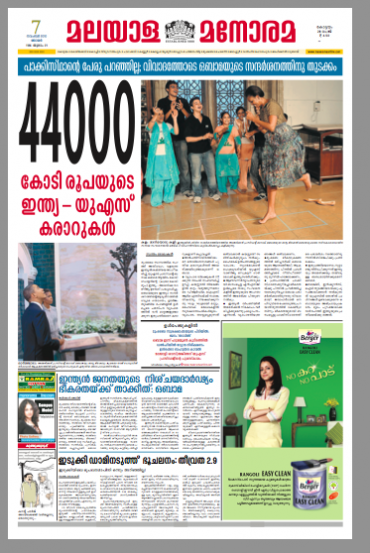TAKEAWAY: This is an industry that needs good, encouraging news, right? Well, take a detour to Kerala, in the scenic cone of southern India, a sort of Land of Oz for newspaper readers.

Recent front page of Malayala Manorama
It has been an intense two days here at Malayala Manorama, the newspaper that is read by approximately 10 million readers daily.
Yes, it takes your breath away just to mention that number in connection with a printed newspaper—-or in any platform for that matter.
My visit here this time has nothing to do with print. We at Garcia Media did a full redesign of Malayala Manorama (in Malayalan) and its sister weekly magazine The Week (in English) in 2004.
Figures just released today, tell us the happy story: Malayala Manorama retains the number 1 position among regional language dailies in India with 99.27 lacs readers (approximately 10 million). With this reanking, Malayala Manorama becomes the 4th largest read newspaper in the country, and the only non-Hindi publication in the top 5 list.
The honor of being number one, the most widely read newspaper in India is Dainik Jagran (Hindi) with close to 16 million readers, followed by Dainik Bhaskar (Hindi), 14 million; Hindustan——a current Garcia Media project—-with almost 11 million. The Times of India (English) is #7 on the list and the most widely read English language daily, with over 7 million daily readers.
By the way, another one of our Indian regional newspaper projects, Sakshi (in Telugu), published in Hyderabad, and which we created as a newspaper in March 2008, ranks #15 on the list with close to 5 million daily readers.
Indian readers take their newspapers seriously, and although the use of mobile telephones is widespread, they are used for conversation more than to read newspapers in them, obviously. As I have travelled through the rural stretch that connects the city of Cochin with Kottayam in scenic Kerala, I was impressed by the number of men and women sitting outdoors, or on the floor, with a newspaper open in front of them.
Are you listening, Ross Dawson?
Dawson, as readers of this blog may know, is the author of a much discussed Newspaper Extinction Deadline. In it, India truly got the honors of being the last country to say goodbye to printed newspapers as we know them.
According to Dawson, it will be India that will pull the plug, sell the old printing presses, turn off the light and hang a sign that reads: Gone apping!
Dawson’s website is about “opportunities for business and society in a hyper-connected world.
I am surprised that so many Indian publishers had no idea they were so honored. Twice this month, while conducting sessions, I have joked that I expect to be working in India till the very end of my career. Heck, I will be 93 in 2040 if I make it that far. But I don’t think I, or anyone, will be helping the Indians to hang that sign outside the door. However, I see surprise in the Indians’ faces when I tell them they have been given the honor of being the last country to still have printed newspapers.
“Nonsense,” a publisher told me here. “Pure nonsense, this prediction.” (I have heard the same reaction from others outside of India)
Not even an hour after this discussion came the report with those incredible, but true, numbers about Indian newspaper readership: 15 million readers here and 10 million there. The newspaper that was #33 on the list , Punya Nagari (in Marathi) even gets two million readers.
“We at Malayala Manorama see various platforms, and we are going to be represented in all of them,” says Mammen Mathew, Editor
And, of course, Mr. Mathew made this statement as he joined us in the kick off of the Malayala Manorama iPad app workshop.
Six years after my first visit here to redesign Malayala Manorama, my visit this time is to help Malayala Manorama as it looks to the future in a new platform—-the tablet.
The iPad workshop
Many ask me what my IPad workshop involves. As I have just completed today here in Kerala, let me share the information with you:
Two days, that is what it takes to get a group of devoted members of the iPad project team ready to understand how the tablet works, how print and online relate to the tablet, how to create a model.
First, the workshop is scheduled as Phase One of the iPad project, once the management has decided to go iPad—-or at least to explore its grand possibilities.
The two-day workshop involves the following:
–-Introduction: a presentation of about 90 minutes outlining all that we know about the iPad and how to get started in the creation of a news app.
-Exploring the existing publiation’s DNA: a discussion of the strenghs of the newspaper or magazine and how to enhance them and give them longer legs on the app.
Sketching: first basic aspects of sketching. I am a firm believer that the discussion of what will be cannot go too far without screens showing it.
Information architecture: a key part of the workshop, involving the entire team, but especially the technical ones, how navigation will be carried out; how do we move from here to there; the maps that lead us to our destinations inside the app. Perhaps the most important point of the workshop.
A final working sketch: at the end of the two days, we have a full working sketch with the main parts of the architecture, content flow, visual details (tyography, color palette) and the basics of storytelling.
Of special interest
The Great Murdoch iPad Debate | The New York Observer
http://www.observer.com/2010/great-murdoch-ipad-debate
Why the iPad should rival the web
http://www.ft.com/cms/s/0/6130938a-fd85-11df-a049-00144feab49a.html?ftcamp=crm/email/2010122/nbe/MediaInternet/product#axzz16wE3T2UF
USA: Wall Street Journal Magazine, New York Section Profitable, CEO Hinton Says
http://www.bloomberg.com/news/2010-12-02/wall-street-journal-magazine-new-york-section-profitable-ceo-hinton-says.html